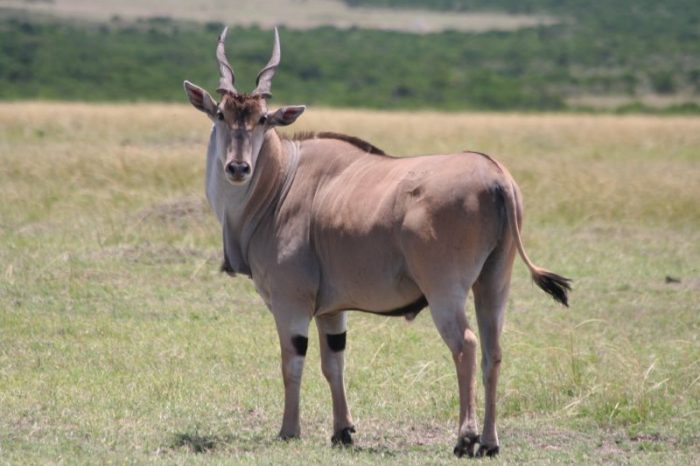
Antelopes are many different species of ungulate that can be found in parts of Eurasia and Africa. African antelopes can be found almost all throughout the African continent. Though some people think of a singular animal when they hear the term antelope, antelope refers to many different species be found in different regions around the world.
The term is actually used to describe members of the bovidae family that aren’t goats, sheep, or cattle. There are currently around 90 different recognized species of antelopes, most of which are native to Africa. Let’s examine some of the most interesting types of antelopes found in Africa.
Eland
The eland is a notable amongst African antelopes for being the largest known species out of all the antelopes on the African continent.
The eland is found mainly in the southern, eastern, and central parts of the continent. The eland’s preferred habitats are montane areas, coastal plains, and semi-arid areas. There are two different species of eland, the common eland and the giant eland. The giant eland, as the name implies, is extremely large for an ungulate with a body length of between 220 to 290 cm or 86 to 114 inches.
The Giant Eland is a vulnerable species according to the International Union for Conservation of Nature. Giant elands have spiral shape horns, and their coat is usually a reddish-brown or chestnut color. The giant eland is found in Western Africa near the countries of Senegal and Mali, and found in Eastern Africa near South Sudan and Cameroon. Meanwhile, the common eland is found on the plains and savannas of southern and eastern Africa.
Gerenuk
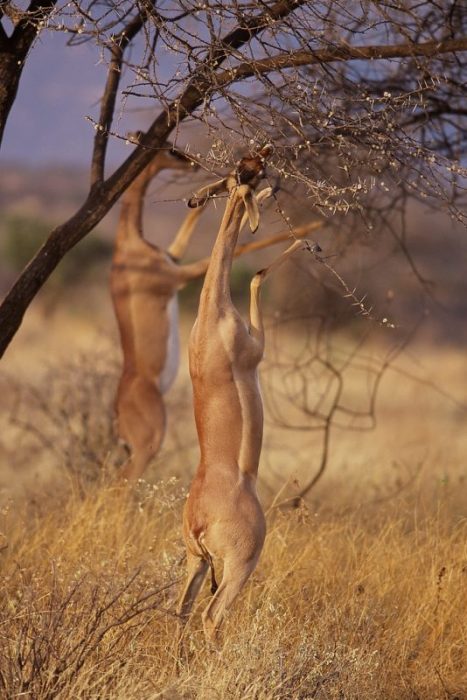
Photo: frederic salein via Wikimedia Commons, CC BY-SA 2.0
Gerenuks are a species of antelope that can be found in the eastern portion of Africa, and they are known for their particularly long necks. Gerenuks can be found in the Horn of Africa as well as drier regions of East Africa. Male gerenuks usually weigh somewhere around 45 kg, while the females of the species are usually around 35 kg. The males of the species are also taller than the females, though only by a few centimeters.
While gerenuks are diurnal and thus mainly active during the day, during the hottest parts of the day they usually rest in the shade of trees, spending the rest of the day foraging for food. The long neck of the gerenuk has given it the moniker “giraffe gazelle”, and because of its neck, it can more easily eat high foliage than competitors in its region. Gerenuks are usually either reddish-brown with lighter regions on their rears.
Impala
Impalas are known for their elegant and graceful appearance, as well as their incredible leaping. Male impalas usually weigh somewhere between 46 to 76 kg while females of the species weigh around 37 to 50 kilograms. Impalas are capable of leaping around 3 m or 10 feet into the air, and can cover distances of around 10 m or 33 feet forward. Impalas are also known for a behavior called stotting, where they leap into the air and kick their hind legs and then lands on all fours. This odd movement may help confuse predators about the direction the animal is moving in.
Impalas can be found throughout eastern and southern Africa, with between 2 to 6 different subspecies. The common Impala is of least concern according to the IUCN, while the black-faced impala is considered vulnerable by the IUCN.
Klipspringer
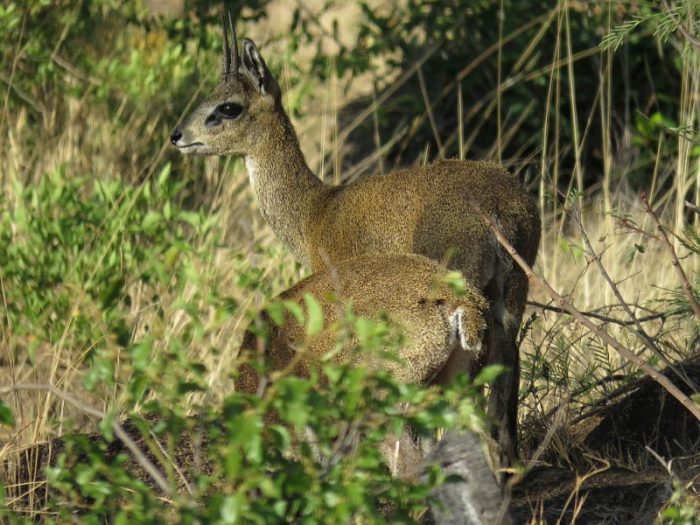
Photo: By Prosthetic Head – Own work, CC BY-SA 4.0, https://commons.wikimedia.org/w/index.php?curid=48294663
Klipspringers are rather small when compared to other antelope, being only about 58 centimeters tall at the shoulder. They inhabit the rocky hillsides of Eastern and southern Africa. Klipspringers can jump impressively high, around 25 feet in height, which is a distance that is approximately 15 times its own height of between 43 – 60 centimeters (17 – 24 inches) tall at the shoulder.
Klipspringers are mainly nocturnal, and are the most active on moonlit nights, foraging for fruits, flowers, and grasses. Klipspringers are also known for their monogamous behavior, which is unusual amongst many antelope. Klipspringers often exhibit life-long pair bonding.
Nyala
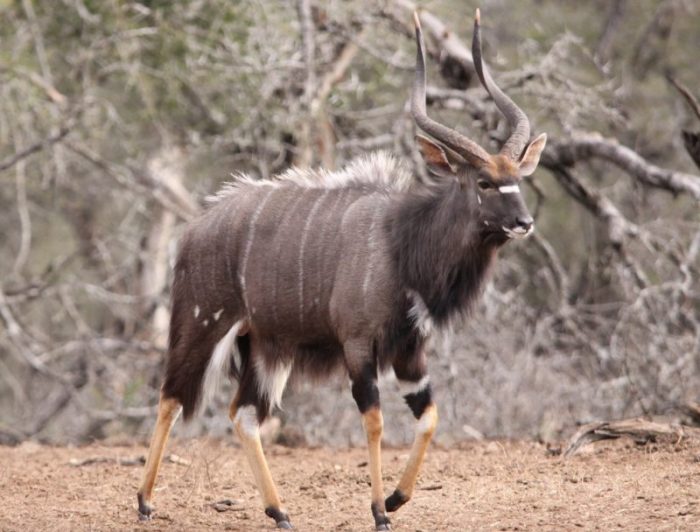
Photo: By Derek Keats from Johannesburg, South Africa – Nyala, Tragelaphus angasi – bull approaching the water holeUploaded by FunkMonk, CC BY 2.0, https://commons.wikimedia.org/w/index.php?curid=23555848
Nyalas don’t have quite the geographic range that some of the other antelopes on this list do, being located only in parts of southeast Africa including South Africa, Zimbabwe, Swaziland, and Malawi. Nyalas have spiral horns and are known for their sexual dimorphism, with males and females of the species being quite different in coloration and size.
The male nyala is dark brown with a number of white vertical stripes running down his body, while the female of the species is a reddish-brown with white vertical stripes. The males of the species can be a good 20 centimeters taller than the females. The nyala tends to be the most active and dawn and dusk, preferring to forage when day temperatures are relatively low, spending the hot hours of the day in clumps of thick brush. Nyala tend to congregate around watering holes in groups of between two to ten members.
Roan

Photo: By Charles J Sharp – Own work, from Sharp Photography, sharpphotography, CC BY-SA 4.0, https://commons.wikimedia.org/w/index.php?curid=55513257
The Roan antelope can be found throughout much of Africa, in the southern, eastern, western, and central portions of the continent. It is one of the largest species of antelope’s overall, measuring around 190 – 240 cm (75 – 94 inches) tall and weighing between 242 to 300 kg (534 – 660 pounds) and the females of the species weighing in around 223 – 280 kilograms overall (492 – 617 lbs).
The roan gets its name from the antelope’s red/brown coat. The roan antelope is often confused with the Sable antelope, and its distinguishing characteristics are its horns (which are shorter than other species), its cloven hooves, its goat-like beard, and it’s tasseled ears.
Sable Antelope
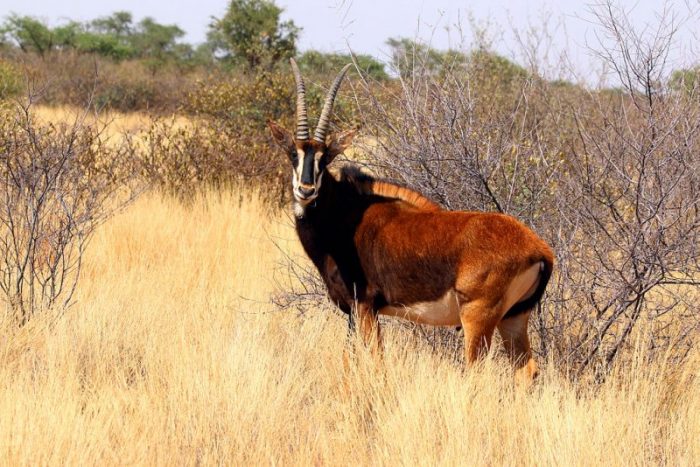
Photo: By Charles J Sharp – Own work, from Sharp Photography, sharpphotography, CC BY-SA 4.0, https://commons.wikimedia.org/w/index.php?curid=37058896
The sable antelope is an antelope which inhabits regions of East Africa and South Africa, spread throughout Kenya and Angola. There are four different subspecies of the sable antelope: the southern sable, the giant sable antelope, and the Zambian sable or eastern sable. Sable antelopes are known for their long, curved, scimitar-shaped horns, which they use to defend themselves from predators, including lions.
Sable antelopes congregate in groups of around 10 to 30 females led by a single bull, while young males will congregate in groups of around 12 individuals. If the herd gets too large it will split up into smaller groups, again lead by only 1 male. The sable antelope is around 120 – 140 cm tall at the shoulder, and it weighs somewhere between 200 to 270 kg. Sable antelopes are sexually dimorphic in nature, with the males generally being larger than the females by about one-fifth. Male sable antelopes usually have a dark brown coat with white hairs below their eyes and on their faces, while females are a slightly lighter chestnut brown.
Waterbuck
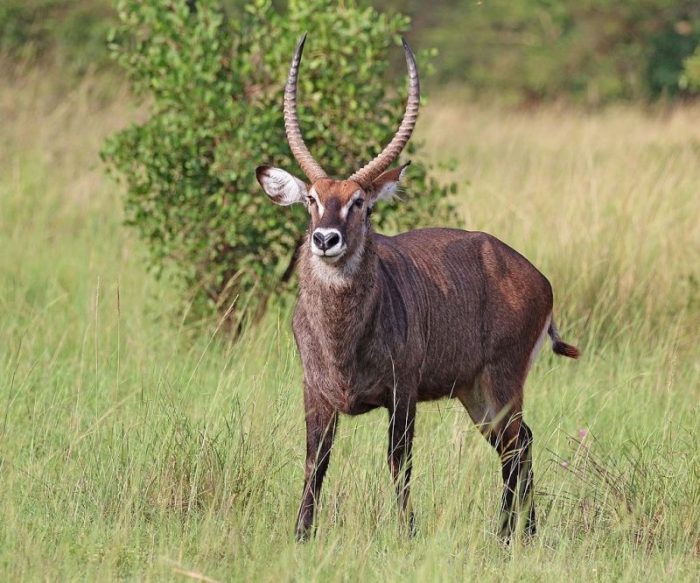
Photo: By Charles J Sharp – Own work, from Sharp Photography, sharpphotography, CC BY-SA 4.0, https://commons.wikimedia.org/w/index.php?curid=37058896
The waterbuck is a species of antelope found throughout sub-Saharan Africa. There are 13 different subspecies of the waterbuck, usually divided into two different groups: the Defassa waterbuck and the Ellispumnus waterbuck. The various subspecies of waterbucks are sexually dimorphic in nature with the males generally being much heavier and taller than the females. Male waterbucks are usually around 127 cm or 50 inches tall at their shoulders, while the females of the species are usually around 120 cm or 47 inches tall. Waterbucks have long, large spiral horns that are curved backwards and can be between 55 to 99 cm or 22 to 39 inches long.
Waterbucks tend to be rather sedentary compared to other kinds of antelope, much less likely to migrate. However, some groups may migrate during the start of the monsoon season. Waterbucks usually form herds that are made up of between 6 to 30 members. Despite their name, they don’t actually spend much time in the water, though the waterbuck may shelter in the water to escape predators.
Wildebeest

Photo: By Derek Keats from Johannesburg, South Africa – Black wildebeest, or white-tailed gnu, Connochaetes gnou at Krugersdorp Game Reserve, Gauteng, South Africa, CC BY 2.0, https://commons.wikimedia.org/w/index.php?curid=54095303
Wildebeests, also sometimes called gnus, are a type of antelope found within the large, wide-open plains and savannas of East and South Africa. There are two different species of wildebeest, the blue wildebeest and the black wildebeests. These two different species of wildebeest have different physical attributes and habitats.
The blue wildebeest is typically a little larger than the black wildebeest, with the males of the species coming in at around 150 cm tall and weighing around 250 kg while the females of the species way around an 80 kg and are around 105 cm tall. Meanwhile, the males of the black wildebeest species are usually around 20 cm tall and 180 kilograms in weight while the females are about 155 kg in weight and around 108 cm tall.
The blue wildebeest can be found in a wider variety of habitats than the black wildebeest, which usually limits itself only to open grasslands. The black wildebeest species usually migrate only a short distance between seasons while the blue wildebeest usually engages and much longer migrations, and during the migrations, many of the antelope die while crossing rivers and being preyed on by alligators or drowning.




